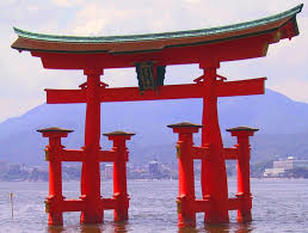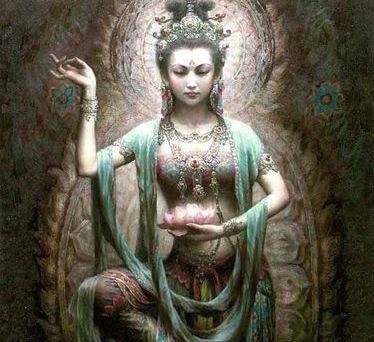 The Zen tradition has passed through patriarchal cultures, in China, Korea, Japan, and now in the West. Yet, somehow it has maintained a strong yin character, a connection to the fertile, receptive aspect of things. In his book “China on the Mind,” Christopher Bollas says that Eastern thinking is based on the “maternal order,” while Western thinking tends to privilege the “paternal order.” The maternal order is experiential, receptive, and pre-verbal. It is strongly present in the relationship with the early mother. In the maternal order are felt experiences of being an embryo and fetus, being born, being an infant, and the mother-infant bond. It tends to not be expressed in language, but rather it is presentational in nature. That is to say, it can best be expressed by gesture, body, breath, rhythm, coherence, and patterning. The patriarchal order, on the other hand, is based in words, logic, discursive thinking, and evaluation. So I’m setting out to explore the maternal order of the Zen tradition. I’m starting with Prajnaparamita, the Mother of all Buddhas. Prajnaparamita is, in one incarnation, a goddess who embodies perfect wisdom. She offers clarity of view, transcendent insight into the way things are. But don’t think this means she is pointing to some kind of ideal. Her kind of perfection isn’t something we have to strive to attain. Rather, it’s the nature of things inherently, just as they are. Prajnaparamita is also the Great Mother, the source of everything, who was worshipped and venerated in the early Ch'an tradition. She is Mother, matrix, guide, gestational body, original love and care. In the sutras, at times she is adored for her generosity, beauty, and fecundity. In another manifestation, Prajnaparamita is also a group of very important early Buddhist sutras that marked the turn to the Mahayana tradition. The Heart Sutra is a distillation of these teachings, and is chanted in Buddhist gatherings around the world. These sutras are understood as coming from the understanding of the goddess Prajnaparamita; this is her wisdom, her care. Traditionally, Prajnaparamita is the locus of the tathagarbha, the womb of being. It is from her womb that all things are born. She is the loom of origins, the source. And because she is marked by perfect wisdom, so everything that comes from her womb is marked by Buddha nature. Everything (even you) is whole and complete just as they are. This is the opposite of original sin; it is original perfection, even amid the difficulty and imperfections of life. We are born of Prajnaparamita, and we always have the potential to realize our Buddha nature, in any moment. Because Prajnaparamita can be powerfully apprehended by her presentation, it’s important to describe her attributes. She is often depicted seated on a lotus throne. The lotus represents the beauty and perfection inherent even in our muddy everyday experience. She carries a sword to cut away delusion. The sword is not used aggressively or violently, but rather to clear away confusion and mistaken views and attachments that obscure our access to her wisdom. She has a sharp quality in a way that can be helpful, to release delusions that keep us small and stuck. Finally, she is beautiful, adorned with jewels, and with a lovely face and body. In this way she allows us to fall in love with her, to gaze upon her with adoration, and also to bring this quality of devotion to other aspects of experience. When we step outside and feel in awe of a tree or flower, we have the same experience of appreciation for the beauty of the world. I recommend getting an image or statue of Prajnaparamita and allowing yourself to meditate in her company. Finally, we come to Prajnaparamita’s mantra. Mantras aren’t used much in Zen, but this one is an exception. We find it at the end of the Heart Sutra, and it’s a powerful invocation of the Great Mother. Like all mantras, the power is not so much in the meaning, but rather in the energy of the sound itself. Chanting Prajnaparamita’s mantra will invoke her into your practice, and may connect you to her capacities to give and receive love and comfort, to offer a gestational body, and to give nurturance and guidance. Try reciting the Prajnaparamita mantra 108 times and see what happens. Here it is. Gate gate paragate parasam gate bodhi svaha Zen is not usually seen as a devotional practice, but invoking the wisdom and generosity of Prajnaparamita can be a source of immense comfort and support. Reposted from 2016.
2 Comments
When I came to Zen practice in my 20s, I wasn't aware of how much pain I carried. I had managed to seem successful by being a good student, having a decent job, even being a good Zen student. But as I sat all the feelings I had pushed down came crashing into view: the massive self-doubt, the desperate need to be loved, all the buried pain I had managed to gloss over. I approached this in my usual way, by trying to follow the rules, to get better at meditation, with the hope that it would all go away. Eventually I was honest with my teacher, who recognized that, instead of striving to "fix" myself, what I really needed was the medicine of compassion. As I began to approach my own suffering with a heart of compassion, it became natural to be able to offer kindness more freely to others. Here's the good news. Compassion is our deepest nature. We don't have to manufacture it, but rather we uncover it. Compassion arises naturally when we see that we are truly interconnected with others. Thick layers of delusion can obscure our access to compassion. We may believe that if we are compassionate with our selves, we will lose motivation, that we need to whip ourselves so we don't get soft. We may believe we are deserving of punishment. The problem of self-hatred and self-condemnation are rampant in our culture. A lack of compassion is often accompanied by agitation, anxiety and fear, judgment of self and others, and quick anger. In our afternoon workshop, Fierce Compassion: Cultivating Radical Kindness for Self and Others, we will explore the stories and habits that occlude compassion, as well as guided practices and tools to allow our innate compassion to shine through. Join us!  What Will I Get Out of Meditation Practice? The popular media these days seems to promise meditation as a cure to all that ails you, from stress to illness to low productivity. And indeed, many people are motivated to take up meditation in response to suffering of one sort or another. But the truth is, real practice won't give you anything you don't already have. We want to make meditation into a self-improvement project. We want to become calmer, wiser, more compassionate, more focused. Over time, we do tend to stumble into these qualities. But we can't just focus on what we want to gain from meditation. The word "meditation" sounds very spiritual, but really all we are doing is sitting still and attending to our breathing. Lots of thoughts and feelings come and go, but at the core we are just sitting there. In this sense, practice is very physical, and very simple. We are just being with things as they are. Often we set out with an understandable wish to gain something from our practice. But meditation is much more about stripping away the workings of our minds that get in the way of seeing things as they are. In the course of this work, we find that we relinquish our opinions, judgments, stories about ourselves and the world, even the self-improvement project. We have to give up all our ideas about how we should be and how other people should be. We even give up our much cherished identity. This can be frightening, but it's also incredibly liberating. What Meditation Won't Help With Much of our suffering comes from difficult relationships and attachments formed in early childhood. We become indelibly shaped in our relationship with ourselves and others by these patterns, many of which are out of our awareness. Meditation alone does not heal early psychological wounds. For this level of suffering, psychotherapy or psychoanalysis are necessary. As a psychologist for 20 years, and as a Zen teacher, I find that a combination of psychotherapy and meditation together is very powerful for many people What Meditation Can Help With What might we hope for as spiritual practice ripens and matures? After a year of regular practice, you will probably find that you are more compassionate toward yourself and others. You will be less emotionally reactive. And you will be more tolerant of all kinds of difficulty, in yourself and in the world. After five years of practice, you will likely be experiencing more clarity about who you are and what's important in life. You should have less angst about yourself, and more inclination to see how you can realistically be of help in the world. After a decade or two of practice, you won't struggle much with life. Your main orientation will be how to best respond to any situation you are in. Not that you will be a perfect person, personality and rough spots endure, but you will be clear and resolved enough about yourself to work with internal and external suffering skillfully. Practice Beyond Meditation: Stepping into Tradition While meditation is central to Zen, it is only one part of its method of transformation. In order to mature in our practice, we must take up other aspects of the tradition. When we enter the path of Zen, we become a part of a very old path that has many ways of teaching and supporting us. By becoming a part of a sangha (spiritual community), we find that we support each others' practice, and vividly experience the truth of interdependence. And when we take a spiritual teacher, we are able to form an intimate relationship devoted to cultivating our realization, finding our blind spots, and working with difficulties along the way. And by studying the teachings of Zen, we learn from the wisdom of our ancestors. In my experience, over years of practice I have been indelibly shaped by taking the precepts and putting them at the center of my life. I've also been fortunate to enlarge the view of practice in the midst of life by immersion in the koan tradition. These are more advanced aspects of practice for those who commit to the Way. But my experience is that the precepts and the koans are a powerful technology for challenging our habits of mind and body, and for waking us up. In order to truly reach mature stages of practice, we are best served by taking on the wisdom of the whole lineage and tradition, and allowing it to work on us. The coin lost in the river is found in the river.
-Zen koan "Tis a delight to be hidden, but a disaster not to be found." -D.W. Winnicott "You gotta be lost to be found." -The Wood Brothers I've been practicing the last couple of weeks, in different settings, the lovely and friendly koan, "The coin lost in the river is found in the river." This koan, from the always amazing Yunmen, often evokes emotion, imagery, and somatic experiences. Try dropping the koan into your meditation and see what happens. Here are some reflections on the koan, your experience may vary. What does the image of a river evoke? Perhaps it's a specific river. Maybe it's a body feeling of flow. Or other feelings, images, memories. How do you experience this coin? Is it just an object, perhaps something of value? A particular kind of coin? Something in your body? Or maybe you didn't even notice the coin. What do you feel you have lost? Can you feel desperate to fill a void, to find something missing, or to fix what's wrong with you? Or perhaps there is a welcome loss, like shedding a skin. What's it like to find, to be found? What do you most want to find? Did you really lose it? What's it like to feel found by a person or group? Indeed, it is a disaster not to be found.  Crimson Gate Meditation Community is dedicated to offering Zen meditation and inquiry, classes, workshops, retreats and depth psychotherapy that integrates contemporary relational meditation practice with the wisdom of psychology. Our community meditations are every Sunday evening from 7:30-9pm. This is a drop in group that is free of charge (donations welcomed) and open all. If you are new to us, please come by 7:15 to get meditation guidance and orientation. Our emphasis is on contemporary practice for modern lives. In our practice we draw on Zen teachings and traditions, as well as contemporary work in psychology, the sciences of complexity and ecosystems, the arts, poetry, philosophy, and social engagement. Zazen—meditation in silence and stillness—study, and shared inquiry are at the heart of everything we do. Through your participation and sincere practice you help create this community for deep inquiry into our lives and the timeless wisdom and compassion of the Buddhist tradition. This realization permeates the world through our everyday actions, words, and thoughts. Our community is connected not by ritual, dogma, or obligation, but by our aspiration and mutual care. Together we cultivate this dynamic process of waking up and growing up. This is our offering to a troubled world. |
Details
AuthorMegan Rundel is the resident teacher at the Crimson Gate Meditation Community in Oakland, CA.. Archives
April 2020
Categories
|



 RSS Feed
RSS Feed